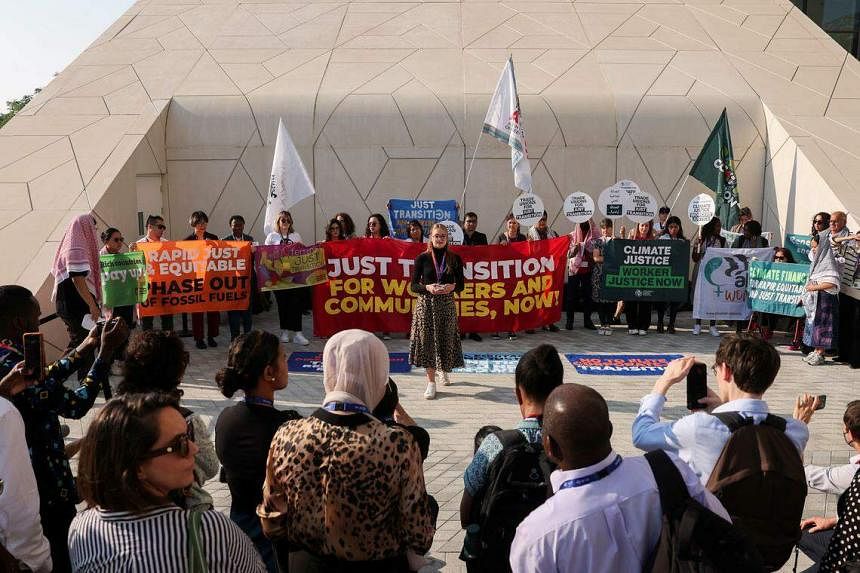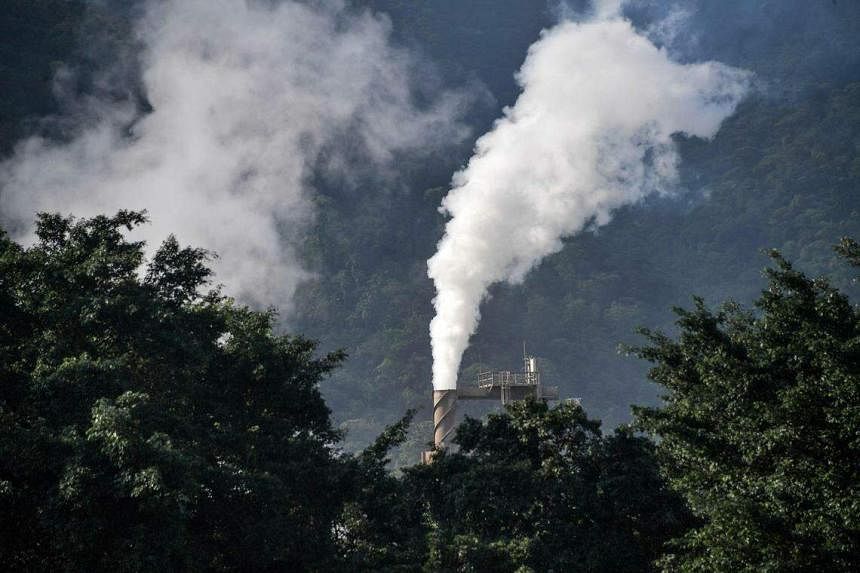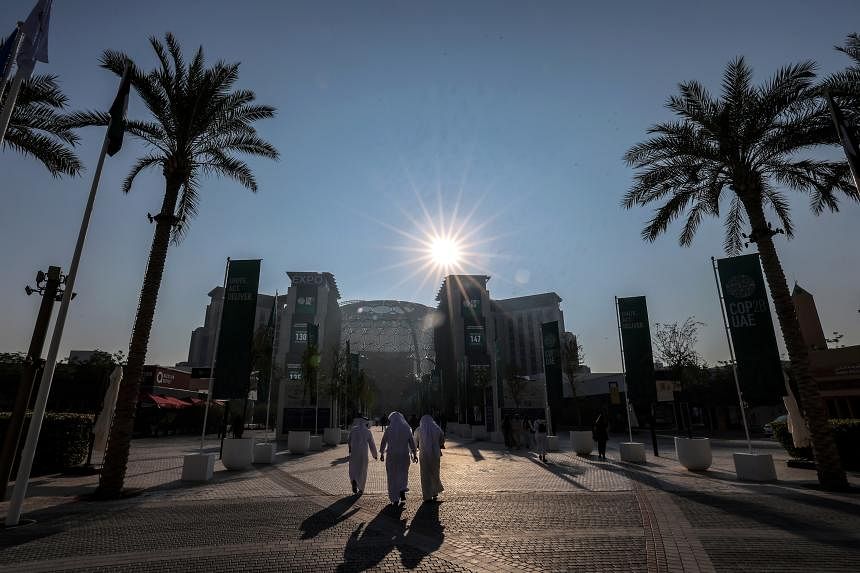DUBAI – With just a few more days to go before the COP28 climate negotiations in Dubai are expected to come to a close on Dec 12, several issues are still at a deadlock.
These range from adaptation – which involves finding ways for developing countries to protect themselves against growing climate risks – and the language surrounding the “phase-out” of fossil fuels.
What does it take to create a more liveable planet for all, and how much progress has been made on these fronts?
To get a sense of the level of ambition at COP conferences, observers and environmental non-governmental organisations often track what is known as the draft text, which is a series of decisions and resolutions that build on the Paris Agreement.
The draft text presents a variety of options for negotiators to hammer out, and strong, decisive language is often indicative that there has been good consensus among countries on certain issues, while vague, ambiguous language and bracketed text often signal disagreement.
The text often goes through many iterations before countries can come to a compromise. Contentious issues are debated right to the end of the conference, and is often the reason why negotiations run into overtime.
Protect at least 30 per cent of earth’s ecosystems, land and oceans, by 2030 (30 by 30)
Countries are expected to contribute to the global goal of increasing coverage of protected areas – up to 30 per cent by 2030 – which was agreed at the Convention on Biological Diversity or COP15 in Montreal in 2022. Conserving nature and restoring degraded areas not only helps to protect existing biodiversity, but can also help with mitigating and adapting to climate change.
Norwegian Foreign Minister Espen Barth Eide, who is co-facilitating negotiations on mitigation at COP28, stressed, during a press conference on Dec 9, the importance of connecting nature to climate, as conserving nature also helps with mitigating greenhouse gas emissions.
“It’s absolutely imperative that we keep the rainforests, that we keep the forest cover, that we look after the health of our oceans because they need to help us (stave off remaining) emissions even when we have phased out most of the fossil fuel emissions,” he said.
Ms Vanessa Morales, a senior expert on climate and energy at the World Wide Fund for Nature (WWF), said: “It is encouraging to see nature-based solutions included in the latest Global Stocktake text. There is still much work ahead to secure the type of guidance and ways forward which will give countries the necessary tools to respond with greater action on nature – including on adaptation and mitigation.
“Crucially, 30 per cent to 50 per cent of land, oceans and freshwater carbon sinks need to be safeguarded and enhanced, and this is yet to be fully acknowledged. We now need to see the language strengthened so it commits governments to accelerate their implementation with the finance and scale required. There is little time left and a lot to do.”
On Dec 9, the COP28 presidency and China, the COP15 president, issued a joint statement calling for countries to coordinate and simultaneously implement their nature and climate strategies. At least US$2.5 billion (S$3.4 billion) has been mobilised so far to protect and restore nature.
Ensuring the world has the ability to cope with the impacts of climate change
With each degree of warming, the world will be experiencing more extreme weather events – from heavy flooding to sea-level rise, highlighting the need for adaptation to climate impacts.
This includes building on higher elevation and investing in coastal protection solutions that can help to guard against sea-level rise. More early warning systems will also be needed to help communities be better prepared for potential disasters.
Yet, negotiations on the Global Goal on Adaptation – essentially a framework that aims to detail how the world can enhance its ability to deal with climate change and strengthen resilience – has been fraught from the beginning, and still remains at a deadlock. In 2022, countries agreed that they would come to a decision on this by the end of COP28.

Creating climate-friendly food, water and health systems
Sustainable agriculture, a resilient supply of freshwater resources and climate-ready healthcare systems will be needed for countries to better cope with the worsening impacts of climate change.
The agriculture sector is a heavy contributor to greenhouse emissions, but it is also vulnerable to climate impacts, highlighting the importance of creating sustainable food systems.
More than 130 countries, including Singapore, have signed a declaration to scale up agricultural adaptation to reduce the vulnerability of farm businesses, promote food security and better manage the use of water in agriculture, among others.
However, negotiations on the implementation of climate action on agriculture and food security are at an impasse, with outcomes to be delayed for another year.
At the same time, more than 120 countries have also signed the Climate and Health Declaration, which acknowledges the need to protect communities and prepare healthcare systems to cope with climate-related health impacts such as extreme heat, air pollution and infectious diseases.
A funding commitment of US$1 billion has also been pledged to strengthen implementation of health-focused climate activities.
Mr Sandeep Chamling Rai, a senior adviser for WWF International’s climate adaptation policy, said that some of the bright spots from the latest draft of the global goal on adaptation was the inclusion of the various themes on adaptation, such as biodiversity, food, water, health and infrastructure, but the language has been a vague so far, and more specific and measurable targets will be needed.
This will be crucial as it gives both developed and developing countries measurable global targets to work with, and can potentially help to channel the relevant finance needed to these areas.
For instance, including targets for health actions and outcomes in the Global Goal on Adaptation would help low- and middle-income countries be better equipped to adapt to a changing climate, and help scientists track whether their health systems are ready to withstand the impacts they are facing, said Dr Jeni Miller, executive director of the Global Climate and Health Alliance.
Rapidly scale up the use of renewable energy, such as solar and wind
A total of 123 countries – including several countries from Asean such as Thailand, Philippines, Malaysia and Singapore – have signed the pledge to triple renewable electricity capacity and double energy efficiency by 2030.
Mr Dave Jones, global insights lead at energy think-tank Ember, said: “Notably, both Vietnam and the Indonesia did not join the pledge, even though Indonesia has plans to more than triple its renewable capacity by 2030.”
He suspects that some countries did not do so because of the pledge’s wording on fossil fuels. For instance, countries agreeing to it will not be able to build new coal power plants, and must move towards an energy system free of unabated fossil fuels by mid-century at the latest.
“This pledge is not a substitute for a global agreement, but it does pave the way for a historic opportunity to continue to be included in the final negotiation text for the global stocktake,” said Mr Jones.
According to the latest draft of the global stocktake text that was released on Dec 9, the goal of tripling renewable energy has been incorporated.
Environmental NGO 350’s associate director of policy campaigns Andreas Sieber said there is “no excuse” for it to be excluded later on when the negotiating text has been finalised, for the sake of the planet’s future health and prosperity.

Phase-out or phase-down of fossil fuels, and by when?
The hottest debate of COP28 was on the phase-out, or phase-down of fossil fuels, particularly with COP28 president Sultan Al Jaber stating that there is “no science” behind the phase-out of fossil fuels.
In response, the COP28 presidency cited reports from the International Energy Agency and the Intergovernmental Panel on Climate Change – the United Nations’ top climate science body – which show that fossil fuel emissions will need to plunge by this decade in keeping the world to a 1.5 deg C warming, although the phasing out of fossil fuels will have a smaller role in the future.
Environmental activism groups have also called for a clear differentiation of fossil fuel phase-out timelines; with richer countries expected to take the lead.
Mr David Tong from advocacy group Oil Change International said that rich countries need to act first and phase out oil and gas production by no later than 2040, possibly earlier, while other countries should aim to do so by 2050.
A lot more climate finance is needed to create a liveable, equitable world for all
At least US$700 million has been pledged to the loss and damage fund so far to help poorer nations cope with costly climate disasters, but finance in other areas – like adaptation – is lacking.
The Adaptation Gap Report published in October states that additional adaptation finance of between US$194 billion and US$366 billion a year is needed by 2030. These typically come from international public finance, countries’ domestic expenditure and private finance.
As adaptation projects are often not profit-driven, garnering private finance will be difficult. As such, at least US$130 billion to US$150 billion per year of international public climate finance should be provided, said WWF International’s Mr Rai.
Yet, it is currently unclear – based on the negotiation text – how much adaptation finance will be given to climate vulnerable countries, or if it will be delivered at all, he added.
Mr Brandon Wu, director of policy and campaigns at NGO ActionAid USA, said: “It doesn’t make a whole lot of sense to talk about a global goal on adaptation in the absence of equity and climate finance. Public funding has to come through in order to ensure that communities (can adapt to climate change).”


